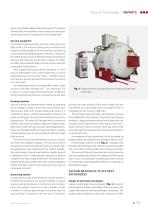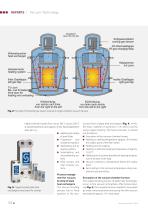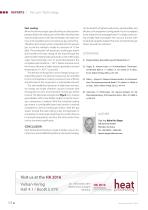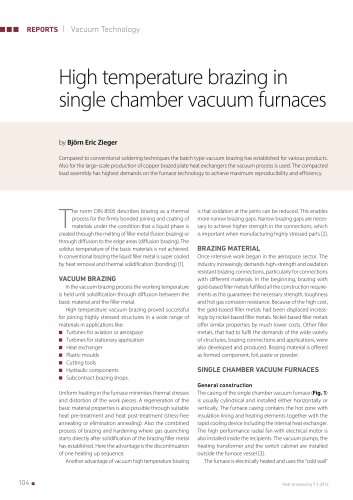
Catalog excerpts

Vacuum Technology High temperature brazing in single chamber vacuum furnaces by Björn Eric Zieger Compared to conventional soldering techniques the batch type vacuum brazing has established for various products. Also for the large-scale production of copper brazed plate heat exchangers the vacuum process is used. The compacted load assembly has highest demands on the furnace technology to achieve maximum reproducibility and efficiency. he norm DIN 8505 describes brazing as a thermal process for the firmly bonded joining and coating of materials under the condition that a liquid phase is created through the melting of filler metal (fusion brazing) or through diffusion to the edge areas (diffusion brazing). The solidus temperature of the basic materials is not achieved. In conventional brazing the liquid filler metal is super cooled by heat removal and thermal solidification (bonding) [1]. VACUUM BRAZING In the vacuum brazing process the working temperature is held until solidification through diffusion between the basic material and the filler metal. High temperature vacuum brazing proved successful for joining highly stressed structures in a wide range of materials in applications like: ■■ Turbines for aviation or aerospace ■■ Turbines for stationary application ■■ Heat exchanger ■■ Plastic moulds ■■ Cutting tools ■■ Hydraulic components ■■ Subcontract brazing shops. Uniform heating in the furnace minimises thermal stresses and distortion of the work pieces. A regeneration of the basic material properties is also possible through suitable heat pre-treatment and heat post-treatment (stress-free annealing or elimination annealing). Also the combined process of brazing and hardening where gas quenching starts directly after solidification of the brazing filler metal has established. Here the advantage is the discontinuation of one heating up sequence. Another advantage of vacuum high temperature brazing is that oxidation at the joints can be reduced. This enables more narrow brazing gaps. Narrow brazing gaps are necessary to achieve higher strength in the connections, which is important when manufacturing highly stressed parts [2]. BRAZING MATERIAL Once intensive work began in the aerospace sector. The industry increasingly demands high-strength and oxidation resistant brazing connections, particularly for connections with different materials. In the beginning, brazing with gold-based filler metals fulfilled all the construction requirements as this guarantees the necessary strength, toughness and hot gas corrosion resistance. Because of the high cost, the gold-based filler metals had been displaced increasingly by nickel-based filler metals. Nickel-based filler metals offer similar properties by much lower costs. Other filler metals, that had to fulfil the demands of the wide variety of structures, brazing connections and applications, were also developed and produced. Brazing material is offered as formed component, foil, paste or powder. SINGLE CHAMBER VACUUM FURNACES General construction The casing of the single chamber vacuum furnace (Fig. 1) is usually cylindrical and installed either horizontally or vertically. The furnace casing contains the hot zone with insulation lining and heating elements together with the rapid cooling device including the internal heat exchanger. The high performance radial fan with electrical motor is also installed inside the recipients. The vacuum pumps, the heating transformer and the switch cabinet are installed outside the furnace vessel [3]. The furnace is electrically heated and uses the “col
Open the catalog to page 1
Vacuum Technology system with double-walled, water-cooled vessel. This reduces thermal load on the metallic furnace casing as the idle losses are conveyed into the cooling water in the double shell. Vacuum equipment A successful brazing process requires a clean and wettable surface. The vacuum brazing process produces the necessary surface quality by the mechanisms of reducing surface oxides and breaking up the oxide skins. Oxide skins are breaking because of the different expansion behaviour between the oxide skin and the basic material. The basic and filler metal materials determine the...
Open the catalog to page 2
Kuhlgasventilator cooling gas blower 2R-Wechselklappe 2R gas changing flaps Warmetauscher heat exchanger Heize emente heating system linke Gasklappe left gas flap Tur zum front door for loading and unloading 1=0 rechte Gasklappe nght gas flap Kuhlrichtung:von rechts nach linksKuhlrichtung:von inks nach rechtsfrom the nght to the leftfrom the left to the nght Fig. 2: Principle of horizontal gas stream reversal in single chamber vacuum furnace highest thermal transfer from minus 180 °C to plus 200 °C at operating pressure up to approx. 35 bar. Typical application areas are e. g.: ■ Heating...
Open the catalog to page 3
Vacuum Technology Heating up to soaking temperature The entire load is heated by radiation. As the setting of the entire load is very compact, the heat radiation must hit the load from all sides to achieve uniform heating. Radiation heating always takes place from the outer area of the load up to the components in the centre of the load setting and from the surface to the core of the individual heat exchanger. Thermocouples are used to realize an absolutely reproducible and safe process. The programmer regulates the process with the help of a heating thermocouple and perhaps one or several...
Open the catalog to page 4
Vacuum Technology Fast cooling When the thermocouples signal that the pre-selected temperature below the solidus point of the filler metal has been reached at all points on all heat exchangers, the load cooling can be speeded up by over-pressure gas quenching. Therefore, the furnace system is flooded with the process gas, in practice nitrogen, usually to a pressure of 1.5 bar (abs). The cooling fan unit produces a cooling gas stream that transfers the heat energy of the load through the opened side heating flaps backwards to the internal gas water heat exchanger unit. To avoid discoloration...
Open the catalog to page 5
